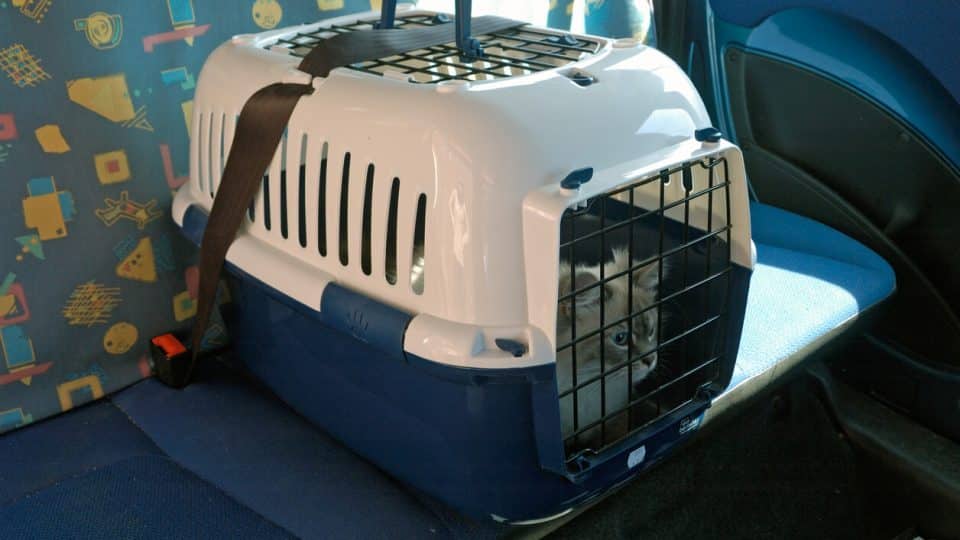- Not a substitute for professional veterinary help.
Natural disasters and emergencies can happen very suddenly, and disaster preparedness is essential for pets as well as people. Being prepared ahead of time can help keep you and your pets safe in an emergency.
Ideally, you’ll take your beloved cat or dog (or both!) with you in the event of a disaster. But if you haven’t put together a disaster kit or prepared your pet to travel, you may risk not just their safety, but also yours and that of rescue teams and others trying to assist you.
Spending some time on disaster preparedness is an important part of pet parenthood. Disaster preparation includes creating a pet emergency plan and kit, practicing for evacuation, and knowing how to help your pet recover, according to Dr. Heather Berst at Zoetis.
Read on to get the details!
How To Create an Emergency Plan
A study of 352 pet parents who experienced a natural disaster or emergency in Australia found that about a third felt unprepared for the event.
Making a plan ahead of time will help you know exactly what to do in an emergency.
When creating your emergency plan, Dr. Berst recommends:
- Finding out which natural disasters occur in your area: Natural disaster risks usually depend on the environment. You can use the National Risk Index to identify the hazards your area may experience.
- Searching for nearby pet-friendly evacuation locations: Over 30 states have laws or emergency operation plans that offer evacuation, rescue, and recovery for animals in a disaster. Do research beforehand to find out where you can evacuate with your pet. You can also try searching for pet-friendly hotels or asking family members if you can stay.
- Microchipping your pet: A microchip is a small identification device placed under your pet’s skin that contains your contact information. This is a handy tool for reuniting with your pet if they happen to get lost. You’ll want to register the microchip with your current phone number so you can be easily reached once someone finds your pet.
- Getting a “rescue alert” sticker for your home: The American Society for the Prevention of Cruelty to Animals (ASPCA) will send you a free pet safety pack that includes stickers to let rescue personnel know pets are inside your home in case of an emergency. If you evacuate, you can leave a note on the sticker saying you’ve evacuated.
- Gathering important documents: Type or neatly print information about your pet, including medical records and vet contact information, and keep it in a waterproof container.
- Preparing a “go kit”: Use the pet emergency kit checklist below and keep these items easily accessible and ready to go in case of an evacuation.
How To Build an Emergency Disaster Kit for Pets
Dr. Berst explains that your pet emergency kit checklist should include food, water, medicine, a first aid kit, important documentation, and pet gear. Store all items in waterproof, airtight containers.
Food and water
- A water and food bowl
- A supply of food and water for at least two weeks
Medicine
- An extra supply of medications that your pet takes regularly
- A month’s supply of flea, tick, and heartworm preventative
- Medications stored in a waterproof container
First aid kit
- Gauze
- Cotton balls
- Isopropyl alcohol
- Hydrogen peroxide
- Antibiotic ointment
- Towel or blanket
- Scissors
- Tweezers
Important documents
- Collar and tag with contact information
- Pet registration or proof of ownership or adoption
- Prescriptions for medications
- Medical records and instructions
- Microchip information
- Pet description, including their name, breed, sex, color, and weight
- A photo of you and your pet for verification if you become separated
Pet gear
- Pet bed
- Crate or pet carrier for each pet, if possible
- Grooming items
- Litter and litter box for cats
- Poop bags
- Familiar items like toys and treats
- Extra leashes and collars
What To Do During an Evacuation
When there’s an evacuation in your area, have your pet emergency kit handy and follow the news and alerts to stay informed on the most current conditions.
Follow instructions from local officials about whether to evacuate or stay put. You can also download the FEMA app for updated weather alerts, emergency shelters in your area, and other important information.
How To Practice for an Emergency or Natural Disaster
FEMA suggests practicing for an evacuation with your pets so they’re comfortable and ready if the time to evacuate comes.
These tips can help you practice for a disaster and get your pet prepared:
- Take car rides: Many pets have car anxiety, but regular car rides can help ease this anxiety. Even if your pet doesn’t have car anxiety, they may be more on edge than usual during a disaster. Bringing your pet along on a car ride, even for a few minutes every few weeks, can make a difference.
- Crate train your pet: If your pet never uses a crate or travel carrier, they may have a hard time riding in one if you ever need to evacuate. You can help them become more comfortable by crate training ahead of time. Try leaving their crate or carrier open with a favorite toy inside. You might also feed them or give them treats inside the crate to make it a more pleasant experience.
- Keep up with obedience training: Training your pet can help keep them safe in unpredictable situations, like a natural disaster. But training also helps build trust so they feel safer overall. It’s important to start training your dog as soon as possible and make it a part of your regular routine. For support, you might work with a professional trainer.
How To Help Pets Recover After a Disaster
Dr. Berst explains that when there’s a natural disaster, pets may experience stress due to:
- Moving to a new location
- Being around different people and animals
- Hearing loud, strange noises
- Seeing their people stressed
According to Dr. Berst, recovery time varies and can take several days to weeks, depending on how easily your pet gets stressed and the seriousness of the disruption.
“As your pet recovers, they may respond to these stressors with a change in bathroom, eating, or playing habits,” Dr. Berst says. They may also have an upset stomach or behave aggressively.
Try these tips to help your pet recover:
- Get them on a regular feeding and exercise routine.
- Don’t make any changes to their food or water.
- Give them space to relax in a calming environment.
- Don’t leave them alone for too long.
- Talk to a vet if you notice unusual changes in their behavior that don’t improve over time.
What Happens to Pets During a Natural Disaster
If you aren’t able to evacuate with your pet or they get lost during the evacuation, the Centers for Disease Control and Prevention (CDC) encourages getting to a safe place before you begin your search.
Many animal organizations, including shelters, will keep pets found during a disaster. Try contacting these groups to find your pet:
- Local humane society
- Animal welfare organization
- County or state animal response team
- Local animal control
If your pet has a microchip, you can also contact the microchip company for support in reuniting with your pet.




